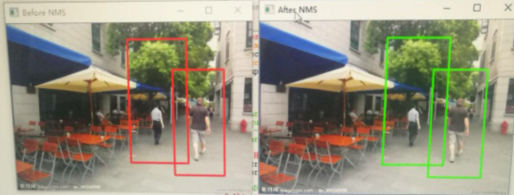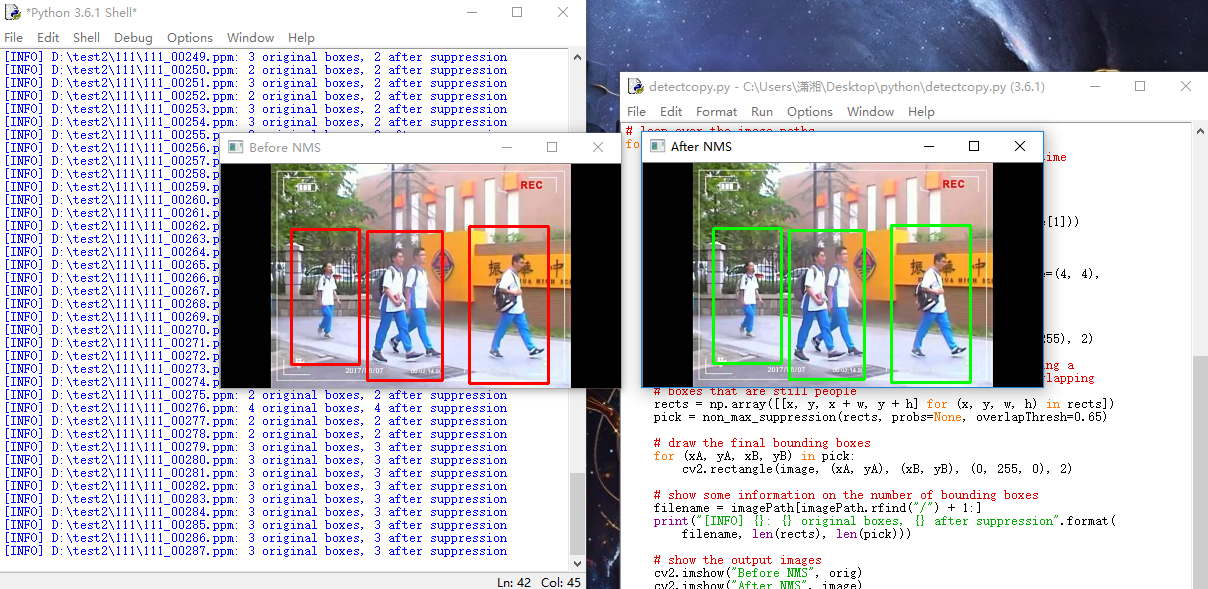利用HOG+SVM实现行人检测
利用HOG+SVM实现行人检测
很久以前做的行人检测,现在稍加温习,上传记录一下。
首先解析视频,提取视频的每一帧形成图片存到磁盘。代码如下
import os
import cv2
videos_src_path = 'D:\\test1'
videos_save_path = 'D:\\test2'
videos = os.listdir(videos_src_path)
videos = filter(lambda x: x.endswith('avi'), videos)
for each_video in videos:
print (each_video)
# get the name of each video, and make the directory to save frames
each_video_name, _ = each_video.split('.')
os.mkdir(videos_save_path + '/' + each_video_name)
each_video_save_full_path = os.path.join(videos_save_path, each_video_name) + '/'
# get the full path of each video, which will open the video tp extract frames
each_video_full_path = os.path.join(videos_src_path, each_video)
cap = cv2.VideoCapture(each_video_full_path)
frame_count = 1
success = True
while(success):
success, frame = cap.read()
print ('Read a new frame: ', success)
params = []
params.append(1)
params.append(1)
cv2.imwrite(each_video_save_full_path + each_video_name + "_%05d.ppm" % frame_count, frame, params)
frame_count = frame_count + 1
cap.release()
对于图片的行人检测应用了梯度方向直方图和支持向量机。代码如下
这段代码可以实现对行人的标记。
# import the necessary packages
from __future__ import print_function
from imutils.object_detection import non_max_suppression
from imutils import paths
import numpy as np
import argparse
import imutils
import cv2
import os
# initialize the HOG descriptor/person detector
hog = cv2.HOGDescriptor()
hog.setSVMDetector(cv2.HOGDescriptor_getDefaultPeopleDetector())
list = []
path = 'D:\\test2\\111'
videos = os.listdir(path)
videos = filter(lambda x: x.endswith('ppm'), videos)
for each in videos:
new_path=path + "\\" + each
list.append(new_path)
# loop over the image paths
for imagePath in list:
# load the image and resize it to (1) reduce detection time
# and (2) improve detection accuracy
image = cv2.imread(imagePath)
image = imutils.resize(image, width=min(400, image.shape[1]))
orig = image.copy()
# detect people in the image
(rects, weights) = hog.detectMultiScale(image, winStride=(4, 4),
padding=(8, 8), scale=1.05)
# draw the original bounding boxes
for (x, y, w, h) in rects:
cv2.rectangle(orig, (x, y), (x + w, y + h), (0, 0, 255), 2)
# apply non-maxima suppression to the bounding boxes using a
# fairly large overlap threshold to try to maintain overlapping
# boxes that are still people
rects = np.array([[x, y, x + w, y + h] for (x, y, w, h) in rects])
pick = non_max_suppression(rects, probs=None, overlapThresh=0.65)
# draw the final bounding boxes
for (xA, yA, xB, yB) in pick:
cv2.rectangle(image, (xA, yA), (xB, yB), (0, 255, 0), 2)
# show some information on the number of bounding boxes
filename = imagePath[imagePath.rfind("/") + 1:]
print("[INFO] {}: {} original boxes, {} after suppression".format(
filename, len(rects), len(pick)))
# show the output images
cv2.imshow("Before NMS", orig)
cv2.imshow("After NMS", image)
cv2.waitKey(1)
在这里应用了非极大值抑制方法(NMS),处理了重叠标记的问题。但是这里存在一个问题就是,部分两个人物距离过近或者产生重叠的情况下,优化后会将两个人标记称为一个人,这个问题还没有解决。
最后,将多张标记后的图片按一定帧数还原成视频,就完成了对视频的行人检测。 完整代码如下
# import the necessary packages
from __future__ import print_function
from imutils.object_detection import non_max_suppression
from imutils import paths
import numpy as np
import argparse
import imutils
import cv2
import os
'''
# construct the argument parse and parse the arguments
ap = argparse.ArgumentParser()
ap.add_argument("-i", "--images", required=True, help="path to images directory")
args = vars(ap.parse_args())
'''
# initialize the HOG descriptor/person detector
hog = cv2.HOGDescriptor()
hog.setSVMDetector(cv2.HOGDescriptor_getDefaultPeopleDetector())
list = []
path = 'D:\\test2\\111'
videos = os.listdir(path)
videos = filter(lambda x: x.endswith('ppm'), videos)
for each in videos:
new_path=path + "\\" + each
list.append(new_path)
fourcc = cv2.VideoWriter_fourcc(*'I420')
videoWriter = cv2.VideoWriter('D:\\test2\\111\\saveVideo.avi',-1,24,(720,404))
# loop over the image paths
for imagePath in list:
# load the image and resize it to (1) reduce detection time
# and (2) improve detection accuracy
image = cv2.imread(imagePath)
if image is None:
break
image = imutils.resize(image, width=min(400, image.shape[1]))
orig = image.copy()
# detect people in the image
(rects, weights) = hog.detectMultiScale(image, winStride=(4, 4),
padding=(8, 8), scale=1.05)
# draw the original bounding boxes
for (x, y, w, h) in rects:
cv2.rectangle(orig, (x, y), (x + w, y + h), (0, 0, 255), 2)
# apply non-maxima suppression to the bounding boxes using a
# fairly large overlap threshold to try to maintain overlapping
# boxes that are still people
rects = np.array([[x, y, x + w, y + h] for (x, y, w, h) in rects])
pick = non_max_suppression(rects, probs=None, overlapThresh=0.65)
# draw the final bounding boxes
for (xA, yA, xB, yB) in pick:
cv2.rectangle(image, (xA, yA), (xB, yB), (0, 255, 0), 2)
# show some information on the number of bounding boxes
filename = imagePath[imagePath.rfind("/") + 1:]
print("[INFO] {}: {} original boxes, {} after suppression".format(
filename, len(rects), len(pick)))
# show the output images
cv2.imshow("Before NMS", orig)
cv2.imshow("After NMS", image)
videoWriter.write(image)
cv2.waitKey(1)
videoWriter.release()
运行截图如下


优化:预处理部分图像结果存在的磁盘上,导致运行速度偏难,可以先加载到内存中,以便加速。
关于视频,没有进行上下文处理,只是单纯的将图片合成视频,没有相互关联起来。
利用HOG+SVM实现行人检测的更多相关文章
- Hog SVM 车辆 行人检测
HOG SVM 车辆检测 近期需要对卡口车辆的车脸进行检测,首先选用一个常规的检测方法即是hog特征与SVM,Hog特征是由dalal在2005年提出的用于道路中行人检测的方法,并且取的了不错的识别效 ...
- OpenCV中基于HOG特征的行人检测
目前基于机器学习方法的行人检测的主流特征描述子之一是HOG(Histogram of Oriented Gradient, 方向梯度直方图).HOG特征是用于目标检测的特征描述子,它通过计算和统计图像 ...
- opencv+树莓PI的基于HOG特征的行人检测
树莓PI远程控制摄像头请参考前文:http://www.cnblogs.com/yuliyang/p/3561209.html 参考:http://answers.opencv.org/questio ...
- HoG SVM 目标检测分析
前一段时间开始了解HoG跟SVM行人识别,看了很多包括Dalal得前辈的文章及经验分享,对HoG理论有了些初步的认识. HoG 的全称是 Histogram of Oriented Gradient, ...
- paper 86:行人检测资源(上)综述文献【转载,以后使用】
行人检测具有极其广泛的应用:智能辅助驾驶,智能监控,行人分析以及智能机器人等领域.从2005年以来行人检测进入了一个快速的发展阶段,但是也存在很多问题还有待解决,主要还是在性能和速度方面还不能达到一个 ...
- PCL行人检测
首先我们知道Hog特征结合SVM分类器已经被广泛应用于图像识别中,尤其在行人检测中获得了极大的成功,HOG+SVM进行行人检测的方法是法国研究人员Dalal在2005的CVPR上提出的,而如今虽然有很 ...
- paper 87:行人检测资源(下)代码数据【转载,以后使用】
这是行人检测相关资源的第二部分:源码和数据集.考虑到实际应用的实时性要求,源码主要是C/C++的.源码和数据集的网址,经过测试都可访问,并注明了这些网址最后更新的日期,供学习和研究进行参考.(欢迎补充 ...
- 行人检测(Pedestrian Detection)资源
一.论文 综述类的文章 [1]P.Dollar, C. Wojek,B. Schiele, et al. Pedestrian detection: an evaluation of the stat ...
- 目标检测之行人检测(Pedestrian Detection)---行人检测之简介0
一.论文 综述类的文章 [1]P.Dollar, C. Wojek,B. Schiele, et al. Pedestrian detection: an evaluation of the stat ...
随机推荐
- centos7 安装 jdk1.8
首先是Linux的不同版本的额系统自带的配置是不一样的,比如centos6上有的自带的jdk环境的话要装1.8的就要进行卸载或者马上进行更改 jdk是java程序依赖的环境 首先查看你的系统下是否有j ...
- android kl文件
android kl(key layout)文件是一个映射文件,是标准linux与anroid的键值映射文件,kl文件可以有很多个,但是它有一个使用优先级: /system/usr/keylayout ...
- spark任务调度和资源分配
Spark调度模式 FIFO和FAIR Spark中的调度模式主要有两种:FIFO和FAIR. 默认情况下Spark的调度模式是FIFO(先进先出),谁先提交谁先执行,后面的任务需要等待 ...
- 2-6 R语言基础 缺失值
#缺失值 Missing Value > #NaN不可识别NA> x <- c(1,NA,2,NA,3) > is.na(x)[1] FALSE TRUE FALSE TRUE ...
- Netty入门(六)Decoder(解码器)
Netty 提供了丰富的解码器抽象基类,主要分为两类: 解码字节到消息(ByteToMessageDecoder 和 ReplayingDecoder) 解码消息到消息(MessageToMessag ...
- 启动报错:Access denied for user 'root'@'localhost' (using password:YES)
项目启动报错:Access denied for user 'root'@'localhost' (using password:YES) 原因:root帐户默认不开放远程访问权限,所以需要修改一下相 ...
- Node.js实战(十)之EventEmitter
Node.js 所有的异步 I/O 操作在完成时都会发送一个事件到事件队列. Node.js 里面的许多对象都会分发事件:一个 net.Server 对象会在每次有新连接时触发一个事件, 一个 fs. ...
- MP实战系列(十二)之封装方法详解(续二)
继续MP实战系列(十一)之封装方法详解(续一)这篇文章之后. 此次要讲的是关于查询. 查询是用的比较多的,查询很重要,好的查询,加上索引如鱼得水,不好的查询加再多索引也是无济于事. 1.selectB ...
- Python2.7-re模块
re模块 1.正则表达式的语法 '.' 匹配任意字符,若指定了re.S,则可以匹配换行符'^' 匹配行首,即字符串的开头,若指定了re.M,会自动匹配每行开头'$' 匹配行尾,同上'*' 匹配大于等于 ...
- kafka 部署
Windows平台kafka环境的搭建 https://blog.csdn.net/u010054969/article/details/70241478
